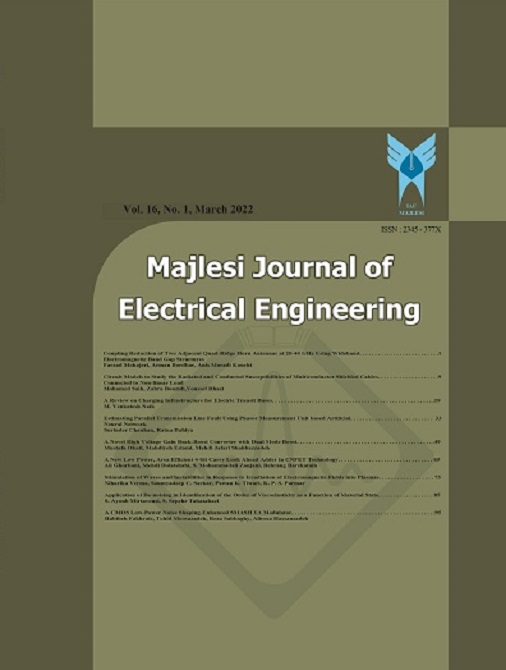Document Type : Reseach Article
Authors
1 Department of Electrical Engineering, Shabestar Branch, Islamic Azad University, Shabestar, Iran
2 Faculty of Electrical and Computer Engineering, University of Tabriz, Tabriz, Iran
3 Faculty of Electrical and Computer, Engineering, University of Tabriz, Tabriz, Iran
Abstract
Switched Boost Inverter (SBI) operates in buck-boost mode with an extensive spectrum of output voltage obtainable from a specific source voltage. Also, this structure provides superior protection against Electromagnetic Wave Interference (EMI) juxtaposed with the traditional impedance source inverter. The number of energy storage elements in this structure has been reduced, which increases the efficiency of the converter in low-power applications, reducing cost, size, and weight. In this paper, this inverter is analyzed and investigated in different operating modes and steady-state. Also, three different pulse width modulation (PWM) control techniques are presented for this inverter. Simulation results are presented in PSCAD-EMTDC software to validate the calculated relationships and confirm their performance in three different switching methods.
Keywords
- [1] Ravindranath, S.K. Mishra, and A. Joshi, “Analysis and PWM control of switched boost Inverter,” IEEE Trans. Power Electron., Vol. 60, No. 12, pp. 5593–5602, Nov. 2013.
- [2] M. Maheri, E. Babaei, M. Sabahi, and S. H. Hosseini, “High step-up DC-DC converter with minimum output voltage ripple,” IEEE Trans. Ind. Electron., Vol. 64, No. 5, pp. 3568-3575, May. 2017.
- [3] Anh-Tuan Huynh, Anh-Vu Ho, and Tae-Won Chun, “Switched-capacitor-inductor active-switched boost inverters with high boost ability,” IEEE Access, Vol. 9, pp. 101543-101554, July 2021.
- [4] S. Kim, S. Lee, W. Cha, and B. Kwon, “High efficient bridgeless three-level power factor correction rectifier,” IEEE Trans. Ind. Electron., Vol. 64, No. 2, pp. 1130-1136, Feb. 2017.
- [5] Babaei, H.M. Suryawanshi, and H. Abu-Rub, “Z-source converters: topologies, modulation techniques, and applications—Part II,” IEEE Trans. Ind. Electron., Vol. 65, No. 10, pp. 8274-8276, Oct. 2018.
- [6] M. Haji-Esmaeili, E. Babaei, and M. Sabahi, “High step-up quasi-Z-source DC–DC converter,” IEEE Trans. Power Electron., Vol. 33, No. 12, pp. 10563-10571, Dec. 2018.
- [7] Z. Peng, “Z-source inverter,” IEEE Trans. Ind. Appl., Vol. 39, No. 2, pp. 504–510, Mar./Apr. 2003.
- [8] Huang, M. Shen, F. Z. Peng, and J. Wang, “Z-source inverter for residential photovoltaic systems,” IEEE Trans. Power Electron., Vol. 21, No. 6, pp. 1776–1782, Nov. 2006.
- [9] Z. Peng, “Z-source inverter for adjustable speed drives,” IEEE Power Electron. Lett., Vol. 1, No. 2, pp. 33–35, Jun. 2003.
- J. Zhou, X. Zhang, P. Xu, andW. X. Shen, “Single-phase uninterruptible power supply based on Z-source inverter,” IEEE Trans. Ind. Electron., Vol. 55, No. 8, pp. 2997–3004, Aug. 2008.
- H. B. Nozadian, E. Babaei, S. H. Hosseini and E. Shokati Asl, “Switched Z-source networks: a review,” IEEE Trans power Electron, Vol. 12, No. 7, pp. 1616-1633, June. 2019.
- Anderson, J., Peng, F.: “Four quasi-Z-source inverters,” in Power Electronics Specialists Conf., Rhodes, Greece, 2008, pp. 2743–2749.
- Fathi and H. Madadi, “Enhanced-Boost Z-Source Inverters with Switched Z-Impedance,” IEEE Trans. Ind. Electron., Vol. 63, No. 2, pp. 691–703, 2016.
- Ebrahimi, E. Babaei and S.M.J. Mousavi, “Diode-Clamped Multilevel Converter Voltage Balancing Using Single Modified Quasi-Z-Source Network,” in PEDSTC, Tehran, Iran, 2022.
- C. Loh, D. Vilathgamuva, Y. S. Lai, G. Chua, and Y. Li, “Pulse-width modulation of Z-source inverters,” IEEE Trans. Power Electron., Vol. 20, No. 6, pp. 1346–1355, Nov. 2005.
- Babaei, E. Shokati Asl, and M. Hasan Babayi, “Steady-state and small-signal analysis of high voltage gain half-bridge switched-boost inverter,” IEEE Trans. Ind. Electron., Vol. 63, No. 6, pp. 3546-3553, June 2016.
- Davaranhagh, E. Babaei, M. Sabahi, and S. Shahmohamadi, “Tapped inductor based switched boost inverter: analysis and implementation,” International Journal of Circuit Theory and Applications, Vol. 50, No. 2, pp. 706-726, Feb. 2022.

